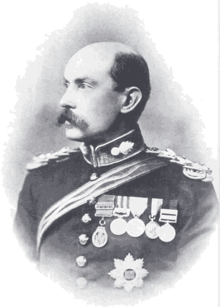James Ronald Leslie Macdonald
|
Sir James Ronald Leslie Macdonald KCSI, KCIE, CB |
|
|---|---|
 |
|
| Commissioner of Uganda (acting) | |
|
In office 30 May 1893 – 4 November 1893 |
|
| Preceded by | Gerald Herbert Portal |
| Succeeded by | Henry Edward Colville |
| Personal details | |
| Born | 8 February 1862 Rajamundry, Madras, India |
| Died | 27 June 1927 (aged 65) Bournemouth, Hampshire, England |
| Profession | Soldier, engineer |
Sir James Ronald Leslie Macdonald, KCSI, KCIE, CB (8 February 1862 – 27 June 1927) was a Scottish engineer, explorer and cartographer. He served as a British Army engineer, rose to the rank of Brigadier-General and was knighted. A balloon observer as a young man, he surveyed for railways in India and East Africa, explored the upper Nile region, commanded balloon sections during wars in South Africa and China and led a major expedition into Tibet in 1903–1904.
Macdonald was born on 8 February 1862 in Rajahmundry in the Madras Presidency, India, and was educated at Aberdeen Grammar School and the University of Aberdeen. He passed through the Royal Military Academy and was gazetted to the Royal Engineers in 1882.
As a lieutenant, on 15 May 1885 Macdonald was appointed to the corps of Bengal Sappers and Miners, Torpedo service, Calcutta on special duty as a balloon photographer. He served in the Hazara campaign of 1888, and also working in the Indian railway organization. Macdonald had spent seven years in service in India and was in Bombay in 1891 ready to embark for England on leave when he was offered the job of Chief Engineer of "the proposed railway survey from Mombasa to the Victoria Nyanza". He accepted, and continued to England to find out what would be involved.
The Imperial British East Africa Company (IBEA Co) commission was to survey a railway route from Mombasa on the Indian Ocean to Port Florence on the shores of Lake Victoria, roughly following the existing caravan route. The Survey began in December 1891, and took more than a year. Macdonald encountered many difficulties in his survey of 27,000 miles of possible route for the railway including sickness, attacks by ants, bees, lions and elephants, formidable physical obstacles and hostile Africans. All these took their toll on his carriers and other followers.
...
Wikipedia
